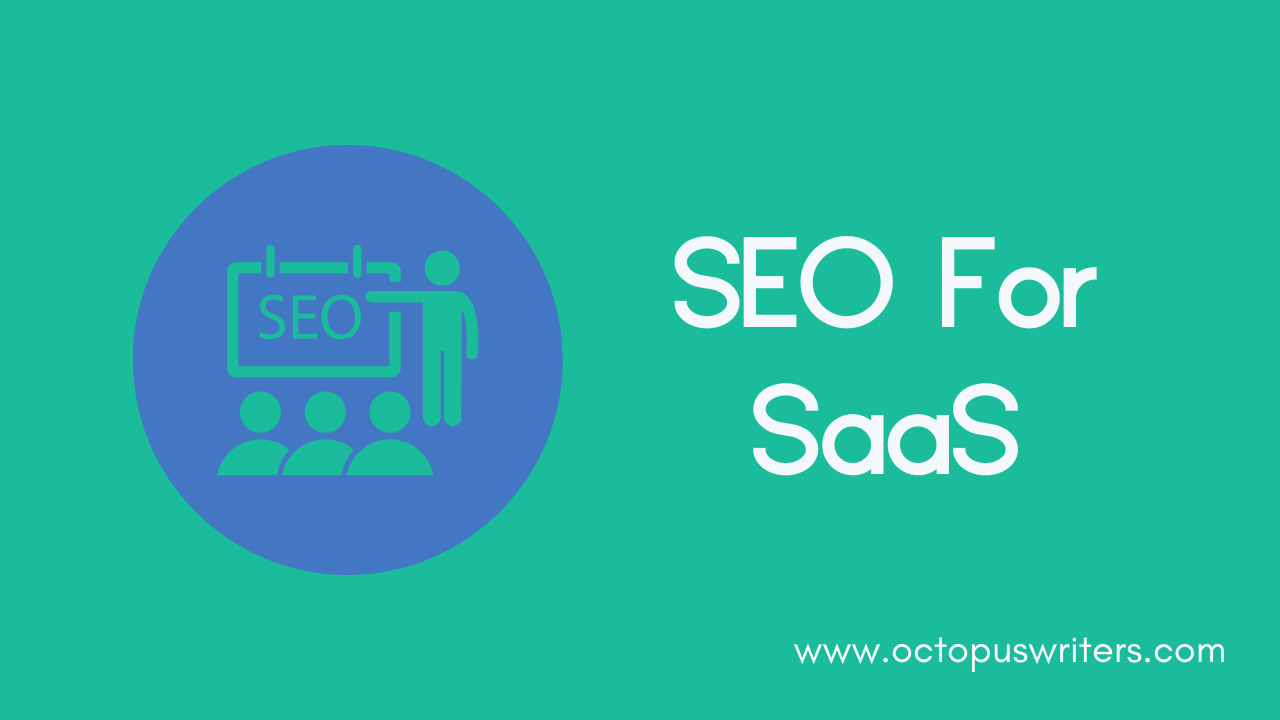SEO for SaaS has no one-size-fits-all formula-achieving success depends on consistently applying proven strategies and techniques aimed at boosting rankings on Google’s Search Engine Results Pages (SERPs). This comprehensive guide will help you master these essential tactics and enhance your online visibility.
With OctopusWriters, you’ll explore actionable insights and practical techniques that can help you gain a competitive edge in search engine rankings over time. Let’s dive into these expert strategies and get you on the path to organic search success.
What Is SaaS SEO?
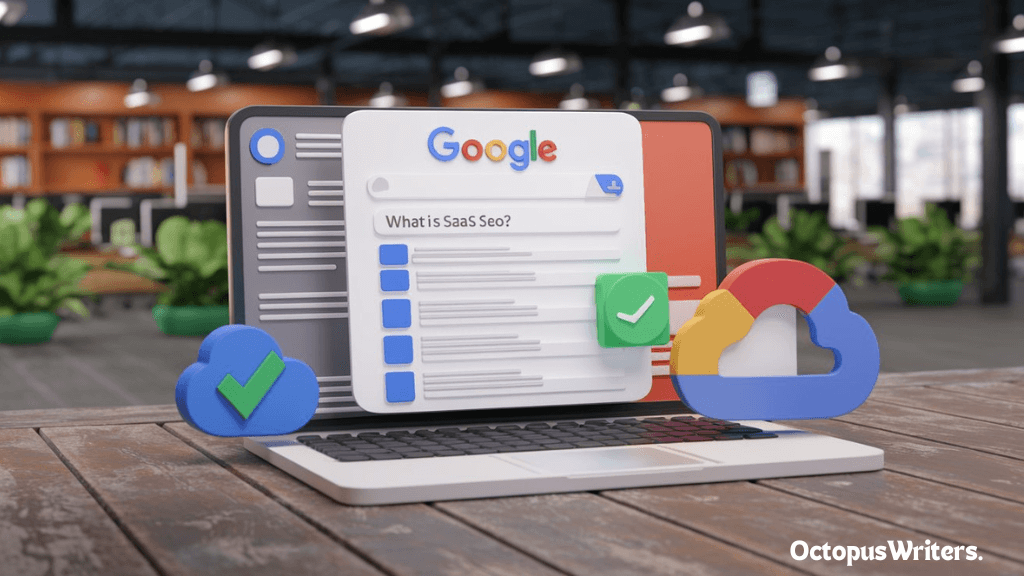
SaaS SEO refers to specialized search engine optimization strategies tailored to the distinctive needs of SaaS (Software as a Service) companies.
At its core, SEO (Search Engine Optimization) involves enhancing a website or online content to improve its visibility on search engine results pages (SERPs).
For SaaS businesses, which provide software solutions accessible over the internet and typically offer subscription-based services, a strong online presence is essential. SEO is crucial for SaaS companies because it drives brand visibility, generates leads, and sustains digital growth.
The Benefits Of SEO For SaaS Startups
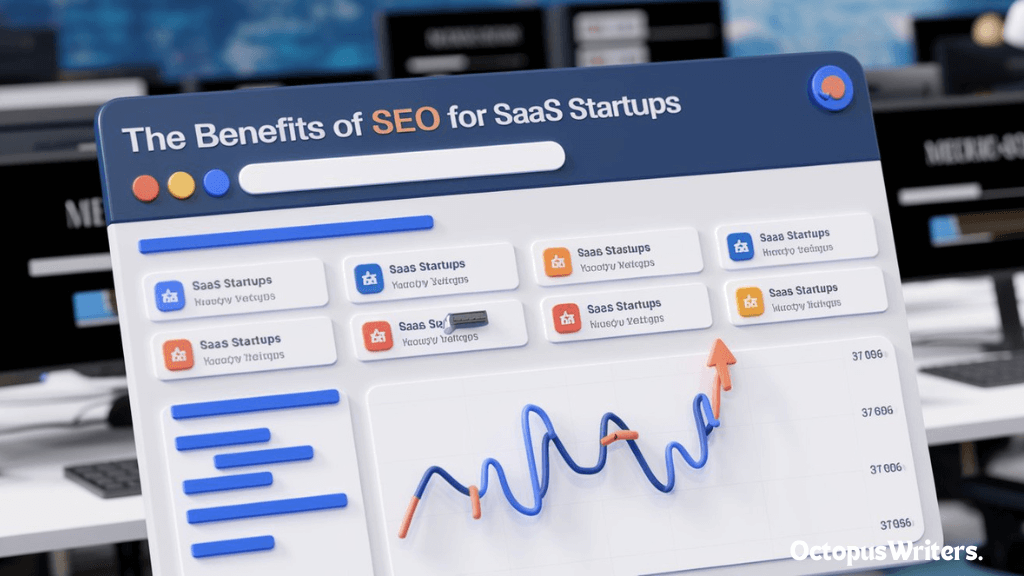
Before delving into the strategies, let’s examine how a well-executed SaaS SEO approach can benefit your startup:
Boosted Monthly Recurring Revenue (MRR): SaaS SEO drives revenue by enhancing visibility, improving conversion rates, and fostering customer loyalty-all of which contribute to a higher Monthly Recurring Revenue.
- Growth in Organic Traffic: A well-planned SEO strategy leads to increased organic search traffic, broadening your brand’s reach and helping prospective customers discover your product without paid ads.
- Cost-Efficient Customer Acquisition: Startups often work within limited budgets, and SEO offers a more sustainable customer acquisition channel compared to high-cost paid marketing, which requires ongoing investment.
- Long-Term Benefits: While SEO may take time to yield results, it builds a foundation for long-lasting visibility and growth, which continues to pay dividends over time.
- Enhanced User Experience (UX): Effective SEO practices often improve website functionality, ensuring a smoother, more enjoyable experience for users-and strengthening their perception of your brand.
- Credibility and Trust: Higher search rankings lend credibility, signaling trustworthiness to potential customers (and investors), which can enhance both acquisition and retention.
- Scalable Insights and Growth: SEO data provides valuable insights into customer behavior, industry trends, and competitor positioning, supporting growth and helping refine other areas like messaging, product development, and PR.
Common Misconceptions Holding Back SaaS Startups
Despite the advantages, some myths prevent SaaS startups from fully embracing SEO. One misconception is that SEO isn’t as impactful as paid advertising. However, SEO’s long-term benefits and cost-effectiveness make it a valuable investment, particularly for attracting high-quality traffic likely to convert.
Another common myth is an overemphasis on rankings. While rankings are a helpful indicator, it’s crucial to prioritize the quality of traffic and conversions, as these metrics more directly influence key performance indicators like MRR.
Why SEO Is Important For SaaS Businesses
SEO is essential for SaaS businesses looking to attract customers actively searching for software solutions. Whether you handle it in-house or partner with a SaaS-focused SEO agency, effective SEO can significantly boost visibility and engagement.
Unlike many other business types, SaaS companies rely heavily on their websites to highlight product features, benefits, pricing, and customer testimonials.
A high-ranking, informative website is essential for driving leads, conversions, and revenue. Here’s why SEO is a vital growth lever for SaaS businesses.
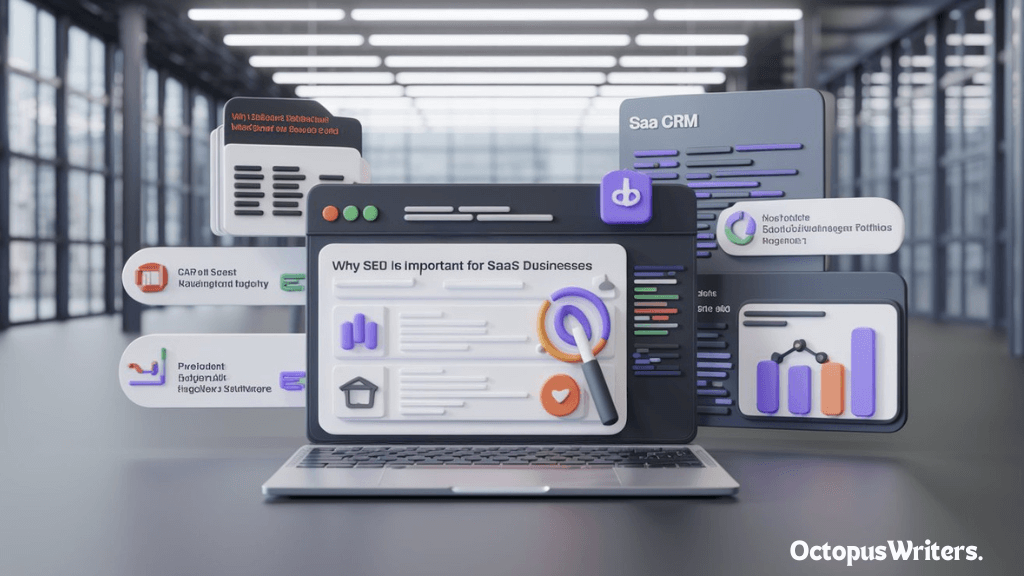
Scale Growth Exponentially
SEO can fuel sustained, high-quality organic traffic to your site. Organic traffic refers to visitors who find your website through unpaid search results, often because they’re actively interested in topics related to your SaaS offering.
By consistently publishing relevant content, your site can rank for a variety of keywords, drawing in traffic from different regions, countries, and languages-expanding your reach and increasing your customer base globally.
This kind of growth is scalable. As you develop more targeted SEO content, the potential for attracting traffic and leads multiplies, a tactic that many SaaS companies leverage for accelerated growth.
Reduce Customer Acquisition Costs
A strong SEO strategy can significantly reduce customer acquisition costs (CAC) while boosting customer lifetime value (CLV). CAC refers to the cost of acquiring a new customer, while CLV represents the revenue earned over the full duration of a customer’s relationship with your business.
SEO stands out as a cost-efficient way to manage CAC and increase CLV.
Consider the difference: In pay-per-click (PPC) campaigns, you pay for each visit to your site. The more clicks you drive, the more it costs. And once you stop paying for ads, the traffic vanishes.
SEO, by contrast, has a compounding effect. Although initial costs may be higher, they decrease as content continues to rank and attract visitors over time, requiring little ongoing investment.
For example, if your SaaS company sells project management tools, SEO could help you rank for keywords like:
- “top project management tools”
- “Agency-focused project management tools”
- “Tips for successful project management”
These search terms reflect various customer needs and stages in the buying journey, and SEO allows you to capture all these audiences without additional costs per visit.
For B2B SaaS companies, in particular, SEO’s cost-effectiveness can be invaluable, as acquisition costs for B2B tend to be higher than for B2C.
Convert Customers From Other Channels
SEO doesn’t just bring in direct traffic; it also reinforces other marketing efforts, such as social media, email, and paid advertising.
By providing more opportunities for interested prospects to engage with your brand. For instance, if someone sees your ads on Google or LinkedIn, SEO can lead them to pages optimized for keywords they’re likely to search. These pages can then be structured to convert visitors into leads or customers, creating a seamless journey from one channel to the next.
How Is SEO For SaaS Different From Traditional SEO?
SEO for SaaS businesses has unique aspects compared to traditional SEO.
First, SaaS SEO emphasizes customer personas and their specific challenges. Understanding who your target audience is, their pain points, and how your software addresses those issues is essential.
Second, SaaS SEO is conversion-focused, especially for B2B SaaS models. Unlike retail or product-based businesses, SaaS companies sell ongoing solutions, so the goal isn’t just to drive traffic but to encourage meaningful actions like sign-ups and free trials.
To achieve this, SaaS SEO uses targeted content formats-such as case studies, product demos, and free trial offers-to illustrate the software’s value at different stages of the customer journey.
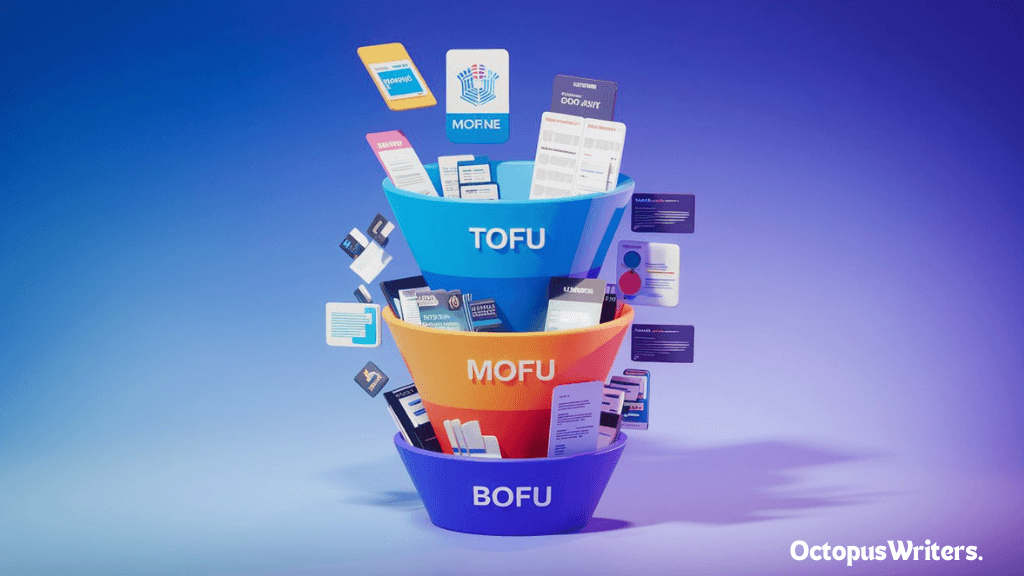
SEO For SaaS And The Marketing Funnel
A strong SaaS SEO strategy aligns with the marketing funnel stages, capturing prospects’ interest from the awareness phase to the final purchase decision.
The marketing funnel maps the customer journey through three main stages: top-of-the-funnel (ToFu), middle-of-the-funnel (MoFu), and bottom-of-the-funnel (BoFu). Tailoring content and keyword strategies to each phase helps attract qualified leads, engage them with relevant information, and eventually convert them into loyal customers.
Top-Of-The-Funnel Keywords For SaaS
Top-of-the-funnel (ToFu) keywords target people searching for solutions to broad problems. At this stage, prospects may not know your product or brand, but they’re interested in learning about the topic.
The goal of targeting ToFu keywords is to build awareness and generate interest in your software’s category, helping prospects see the broader benefits of your solution.
Effective ToFu content types include:
- Blog articles
- Ebooks
- How-to guides
- Videos
Middle-Of-The-Funnel Keywords For SaaS
Middle-of-the-funnel (MoFu) keywords are for prospects who know a solution exists and are evaluating their options. They’re looking for comparisons, feature lists, and in-depth information to make informed decisions.
Content that works well here emphasizes your product’s value, differentiators, and user success stories.
Effective MoFu content types include:
- Case studies
- Customer testimonials
- Product feature explanations
- Demos
Bottom-Of-The-Funnel Keywords For SaaS
Bottom-of-the-funnel (BoFu) keywords target prospects who are ready to buy or sign up. They know about your product and need a final incentive to take action.
Content at this stage should reinforce your software’s advantages, offer potential incentives, and provide social proof to build confidence.
Effective BoFu content types include:
- Landing pages
- Sales pages
- FAQs
- Special offers or discounts
Integrating All Aspects Of The Marketing Funnel
It’s important to remember that prospects can move through the funnel in non-linear ways. Some leads might jump from considering a purchase back to exploring high-level content, or quickly progress from awareness to a buying decision.
By interlinking content across all funnel stages, you create a seamless path that lets prospects explore your offerings at their own pace, ultimately guiding them toward conversion.
Why You Need SEO For Your SaaS Website
SEO is a crucial and effective strategy for SaaS companies to attract potential customers-whether those customers are searching for your product directly or exploring related solutions. Beyond visibility, SEO drives a powerful, cost-effective traffic channel compared to alternatives like paid advertising.
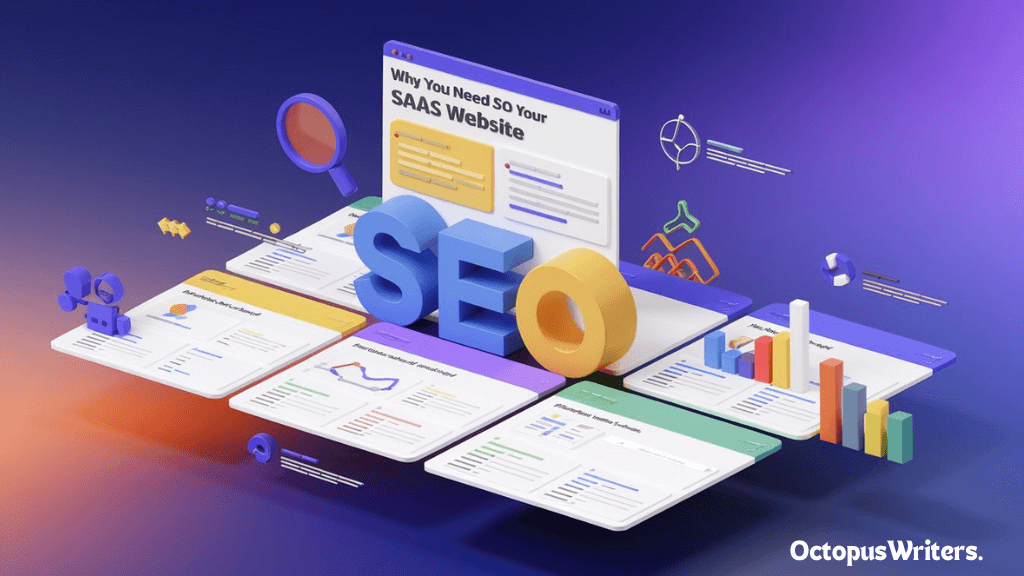
Get Clicks Without Paying For Them
Investing in SEO-optimized content takes some initial resources, but once created, this content can continually generate traffic and convert users without additional per-click expenses. This long-lasting impact makes SEO a valuable, long-term investment. Unlike paid ads that require constant funding, SEO keeps working in the background, building brand awareness and shaping how prospects perceive your SaaS product.
Reduce Your Expenses For Gaining New Customers
SEO can help significantly reduce your customer acquisition costs (CAC). While there are upfront costs associated with content creation and optimization, the cost per acquisition gradually decreases as content continues to attract qualified leads over time. After the initial investment, ongoing expenses are minimal, generally limited to periodic content updates and maintenance.
On the other hand, CAC for paid ads remains high and can even increase as competition grows. Although SEO also faces competitiveness, most costs are concentrated at the start, offering a more scalable and cost-effective customer acquisition approach.
Things To Consider When Creating Your SEO Strategy
From understanding your target audience to choosing the right keywords and optimizing your content, a well-rounded approach can make all the difference in reaching your goals. Here, we’ll explore key considerations that can help shape a successful SEO strategy tailored to your business needs and market dynamics.

Doing It Yourself Vs Hiring An SEO Agency
Many agencies specialize exclusively in SEO, with some focusing specifically on SaaS companies. Although it’s possible to manage SEO in-house, outsourcing is often the most effective option for SaaS companies. Here’s why:
- Agencies bring years of expertise within your industry, removing the need for internal training.
- They offer an outsider’s perspective, using tested strategies from other SaaS clients to fuel your growth.
- They continually monitor and improve SEO performance, allowing your internal team to focus on core priorities.
For a growing SaaS company, this specialized support can make scaling smoother, helping to minimize the risk of issues arising when demand increases. Unless your SaaS product itself is SEO software, having an agency handle this can be a wise choice.
Quick Wins Vs Long-Term Goals
SEO requires patience as your site’s authority gradually builds, but that doesn’t mean you can’t see quick wins. By targeting low-competition, niche keywords, you can secure some page-one rankings quickly, which helps establish trust and authority that will support ranking for more competitive terms down the line.
For instance, top-of-the-funnel content can attract new prospects, while bottom-of-the-funnel content targeting transactional keywords can convert leads. Tailor your strategy to your SaaS goals and your website’s current authority to strike the right balance between short-term and long-term outcomes.
Ranking Sales Pages Vs Blog Content
As a SaaS business, ranking your sales pages for primary target keywords is a priority. However, sometimes the top results on Google are not sales pages but informational or resource content.
If direct ranking isn’t viable, there are other SEO approaches to bring potential customers to your sales pages. For example, create content similar to the high-ranking resources on your target keywords. Use this content as a bridge, directing leads from these high-value pieces to your sales pages. This approach allows you to align with search trends while still guiding prospects toward your product.
Best Practices For Improving Your SaaS SEO Strategy
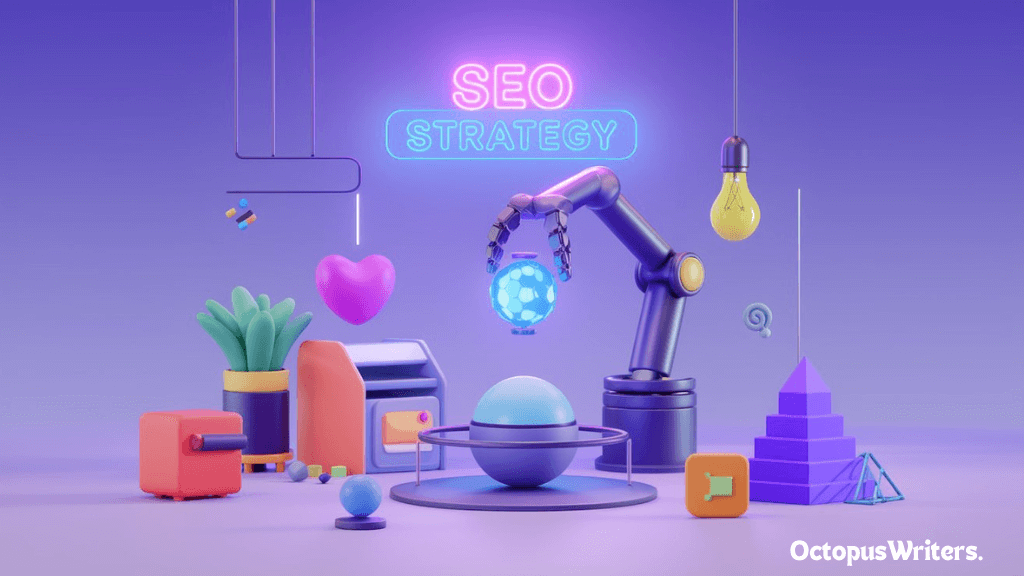
Keyword Research For SaaS Companies
Effective SEO for SaaS starts with strong keyword research. Before diving into SaaS-specific SEO tactics, let’s look at the essentials of keyword research.
Keyword Research Basics
Keyword research identifies search terms people use to find information on platforms like Google. For example, if you’re exploring SEO for SaaS, you might search for terms like “SaaS SEO” or “SEO strategies for SaaS.” These search terms are your “keywords.”
Keywords provide insights into audience intent, guiding content creation, link building, and on-page SEO. Without them, even the most well-planned SEO strategy risks missing its target.
How To Find Keyword Ideas
To discover keywords that attract your audience, first define customer personas-this includes studying your customers’ demographics, interests, and pain points. Knowing these will make it easier to predict the keywords they’re likely to use.
Start by identifying “seed” keywords, the simple terms that reflect your core services. These will help you build a broader list of relevant keywords.
For SaaS, optimizing landing pages with targeted keywords is essential, as these pages serve as entry points for potential customers. Tools like Ahrefs, Semrush, and Moz can help you find the right keywords, helping increase the chances of conversion by aligning with user intent.
Metrics To Analyze Keywords
Analyzing keywords involves assessing specific metrics to help you choose the best options for your SaaS website. Most keyword tools provide valuable data on these metrics.
- Search Volume: Search volume indicates how often a keyword is searched in a given time (usually monthly). High search volume can mean greater potential traffic but often comes with high competition, making it challenging to rank.
- Keyword Difficulty: Keyword Difficulty (KD) measures how hard it is to rank for a keyword, especially if high-authority sites are already targeting it. Keywords with high search volume typically have high KD, so newer sites may benefit from targeting lower-difficulty keywords.
- Organic Click-Through Rate (CTR): CTR estimates the percentage of users likely to click on an organic search result. Keywords with a high CTR are more likely to drive traffic, especially if they’re less impacted by ads or featured snippets.
- Traffic Potential: Traffic potential looks at a keyword’s long-term relevance. Since SEO results take time, keywords should have sustained value. Google Trends can help gauge a keyword’s future traffic potential.
- Cost Per Click (CPC): CPC indicates a keyword’s commercial intent, revealing its profitability. High CPC suggests a stronger conversion potential, making it valuable for keywords aimed at driving sales and conversions in SaaS.
Each of these metrics helps refine your keyword strategy, ensuring your choices align with traffic, competition, and conversion goals.
On-Page SEO For SaaS Companies
On-page SEO offers more control and is generally simpler to implement. Here’s a quick guide to on-page tactics for your SaaS business.
How To Optimize Your Content
- Include Keywords in Titles: Use target keywords in your title tag to show Google what your page covers. Placing the keyword at the beginning of the title adds extra weight.
- Create Short, Descriptive URLs: Descriptive URLs (like “https://example.com/email-marketing/”) help Google and users understand page content better than automatically generated URLs with random characters.
- Write an Engaging Meta Description: A well-crafted, keyword-rich meta description can boost your click-through rate (CTR) by encouraging users to visit your page.
- Optimize Headings and Content: Use keywords in headings and subheadings to clarify your content’s focus to Google. Include a mix of short-tail, long-tail, and related keywords for a well-rounded approach.
- Optimize Images: Name images with descriptive, keyword-focused filenames, and include keyword-rich alt text. Alt text also improves accessibility, helping users with disabilities understand image content.
- Compress Images: Website speed is crucial for SEO, as Google prioritizes fast-loading sites to enhance user experience. Large images can slow down your site significantly, impacting your rankings. Tools like TinyJPG and TinyPNG reduce file size without sacrificing quality.
- Add Internal and External Links: Internal links connect pages within your site, helping Google understand your site structure and boosting SEO. Keyword-rich internal links enhance navigation, keep users on your site longer, and distribute SEO benefits across pages. Similarly, external links to reputable sources provide extra value to users, improving their experience. Use both link types for better SEO and user engagement.
- Avoid Keyword Stuffing and Cannibalization: Overusing keywords (keyword stuffing) can make content unreadable and lead Google to flag it as spam. Additionally, avoid keyword cannibalization, where multiple pages compete for the same keyword, weakening rankings. If pages overlap, consider merging them to boost SEO and improve user experience.
Advanced On-Page Optimizations
Take your on-page SEO to the next level with these advanced techniques designed specifically for SaaS businesses.
- Optimize for Featured Snippets: Featured snippets are concise answers displayed at the top of some Google search results. These snippets respond to questions in a quick, clear format. Securing a featured snippet position can give your SaaS brand a strong competitive edge by boosting visibility and credibility.
- Create Link Magnets: Link magnets, or high-quality backlinks, are links from other sites directing users to your website. Backlinks are essential for SEO; when you attract links from authoritative and relevant sites, Google interprets this as a positive ranking signal, enhancing your website’s authority.
- Achieve Rich Results with Schema Markup: Schema markup is a specialized code that makes it easier for Google to interpret and categorize the content on your page. By implementing schema markup, your website can appear in Google’s rich results, helping it stand out in search results and increasing click-through rates.
- Boost Topical Relevance: Topical relevance, also known as topical authority, measures how well your site’s content aligns with a specific subject or keyword. To build topical relevance, produce content that covers your topic thoroughly and in detail, positioning your site as an authoritative source.
- Target Related Keywords and ‘People Also Ask’ Terms: Enhance your topical authority by focusing on related keywords and terms that appear in Google’s “People Also Ask” sections. These terms are closely connected to your primary keywords and help broaden the relevance of your content.
- Conduct a TF-IDF Analysis: Term Frequency-Inverse Document Frequency (TF-IDF) analysis calculates the significance of keywords on your page compared to competitors’ pages. This analysis identifies keywords or themes your content may be lacking. By adding these keywords, you can increase your page’s topical relevance and overall SEO performance.
Technical SEO For SaaS Companies
Technical SEO is arguably the foundation of any SEO strategy. This aspect of SEO ensures that search engines can properly crawl and index your website, allowing other SEO tactics to actually impact your site’s visibility. Without a solid technical foundation, even the best keyword optimization or content strategies can fall flat.
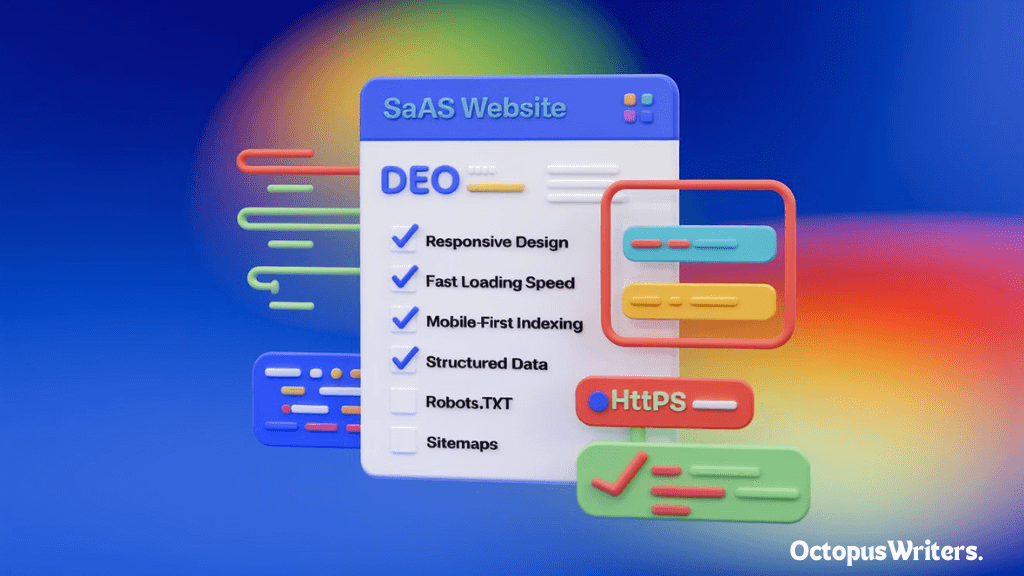
Technical SEO Basics
Crawling is the process by which search engine bots navigate through website content and links to gather information. Search engine crawlers follow links from one page to another, indexing content they find relevant.
You can control which pages these crawlers access using a robots.txt file, directing them to or away from specific pages. For detailed insight into your website’s crawl activity, check out the Crawl Stats report in Google Search Console.
Indexing refers to how search engines store and organize the content they’ve crawled, allowing it to be retrieved quickly for search queries. As Wikipedia explains, “Search engine indexing is the collecting, parsing, and storing of data to facilitate fast and accurate information retrieval.” If Google crawlers successfully index your pages, they’ll be visible in search results when users search for related content.
Technical SEO Strategies
- Verify Page Indexing: Ensuring that your site’s pages are indexed by Google is critical for visibility. Use Google Search Console’s “URL Inspection” tool to verify indexing for individual URLs, and tools like Ahrefs or Semrush for bulk indexing checks.
- Reclaim Lost Links with Redirects: URL changes can result in lost inbound links from other sites. Reclaim these links by implementing 301 redirects, which transfer authority from old URLs to new ones, helping to retain valuable link equity.
- Use Internal Links Strategically: Internal linking distributes page authority across your site, allowing search engines to better understand your content structure. Internal links also enhance user experience by offering additional relevant information, increasing engagement.
- Leverage Schema Markup: Schema markup provides context for search engines, allowing them to interpret your content with greater accuracy. Adding schema markup can improve your chances of appearing in rich snippets, enhancing search visibility and click-through rates.
Additional Technical SEO Techniques For SaaS Websites
Google’s page experience signals evaluate a webpage’s overall UX. This includes:
- Core Web Vitals: These metrics-Largest Contentful Paint (LCP), Cumulative Layout Shift (CLS), and First Input Delay (FID)-measure loading speed, visual stability, and interactivity.
- HTTPS Security: Implementing an SSL certificate establishes HTTPS, securing data exchanges between your site and users.
- Mobile-Friendliness: With more users browsing on mobile, responsive design is crucial. Test your site on different devices to ensure optimal mobile functionality.
- Safe Browsing: Search engines also check for any harmful content, ensuring a safe user experience.
Interstitials: Limit intrusive pop-ups and ads, which can disrupt user interaction with your content.
If your website has content in multiple languages, Hreflang tags can help direct users to the correct language version. This tag tells search engines the intended language and location for each page, enhancing user experience for international audiences.
Content Marketing Strategy For SaaS Companies
Content marketing is a vital asset for SaaS businesses, driving growth from the ground up. Unlike eCommerce or service-based industries, SaaS companies must educate and build trust with potential customers through high-quality, thought-leadership content. Strong content marketing at the top of the funnel can set the stage for customer acquisition, while middle and bottom-funnel content solidifies product choice and fosters brand loyalty.
Why Is Content Marketing For SaaS Companies Different?
Marketing for SaaS stands apart because it involves promoting both a product and a long-term service relationship. SaaS customers evaluate not only product features but also the support and reliability of the provider. To succeed, your content strategy must highlight both aspects, as a great product alone won’t drive loyalty without quality support.
Additionally, SaaS content marketing leans heavily on SEO-driven inbound strategies, leveraging search engine visibility to build brand authority and attract engaged users organically.
Key Elements Of A Successful Content Marketing Strategy For SaaS Businesses
An effective SaaS content marketing strategy starts with in-depth market research to uncover what your audience truly needs. This leads to high-quality content creation and strong promotion tactics. Here’s what makes a SaaS content strategy successful:
- Audience Insight: Understand your audience to create content that resonates with their needs.
- Keyword Analysis: Focus on keywords addressing customer pain points.
- Content for Every Funnel Stage: Tailor content for top, middle, and bottom funnel audiences.
- High-Quality Content Creation: Develop well-researched, valuable content.
- Multi-Channel Promotion: Use email, social media, and news publications to maximize reach.
- Performance Tracking and Optimization: Monitor results and refine based on analytics.
We’ve already discussed audience and keyword research. Next, we’ll cover content creation, distribution, and tracking.
Successful Content Types For SaaS
For SaaS companies, certain types of content consistently drive engagement and conversions. Here’s a list of proven formats:
- Pillar & Cluster Content: Pillar content is a comprehensive guide covering all aspects of a topic, supported by cluster pages that delve into related subtopics. This structure ensures users find everything they need on the subject, boosting SEO and user retention.
- Use Case Content: Create content that speaks to different user personas, such as solopreneurs, small business owners, or enterprise marketers. Tailored articles, landing pages, and resources like eBooks or white papers for each use case enhance relevance and conversion rates.
- Expert Roundups: Compile insights from industry experts on a key topic. This not only elevates your content’s authority but also draws the attention of top voices and publishers in your field, increasing brand awareness.
- Case Studies: Case studies showcase real-world examples of how your SaaS solution addresses user pain points, especially useful for potential customers in the consideration stage.
- Podcasts & Interviews for Thought Leadership: Establish your SaaS brand as a thought leader by participating in or hosting podcasts and interviews. This format helps build trust by spotlighting both your expertise and the insights of industry leaders.
Link Building & Pr For SaaS Companies
Backlinks are crucial for SEO, especially in the competitive SaaS landscape. High-quality links are among Google’s top ranking factors, and they can significantly improve your website’s search performance. Public relations (PR) works similarly to enhance visibility and authority. Let’s break down these strategies.
The Importance Of Link Building For Software As A Service Firms
For SaaS businesses, link building is essential to increase search engine visibility. Without relevant, high-quality backlinks, climbing the search rankings becomes challenging. These links not only boost authority in your niche but also build credibility. When reputable sites link to your content, it reflects positively on your brand, enhancing user trust.
Evaluating SEO Performance For Software As A Service Businesses
Tracking SEO performance is crucial to assess your campaigns and make improvements. Start with core metrics: rankings, organic traffic, and conversions. By regularly evaluating these, you can spot gaps and optimize your strategy effectively.
Bonus SaaS SEO Tips
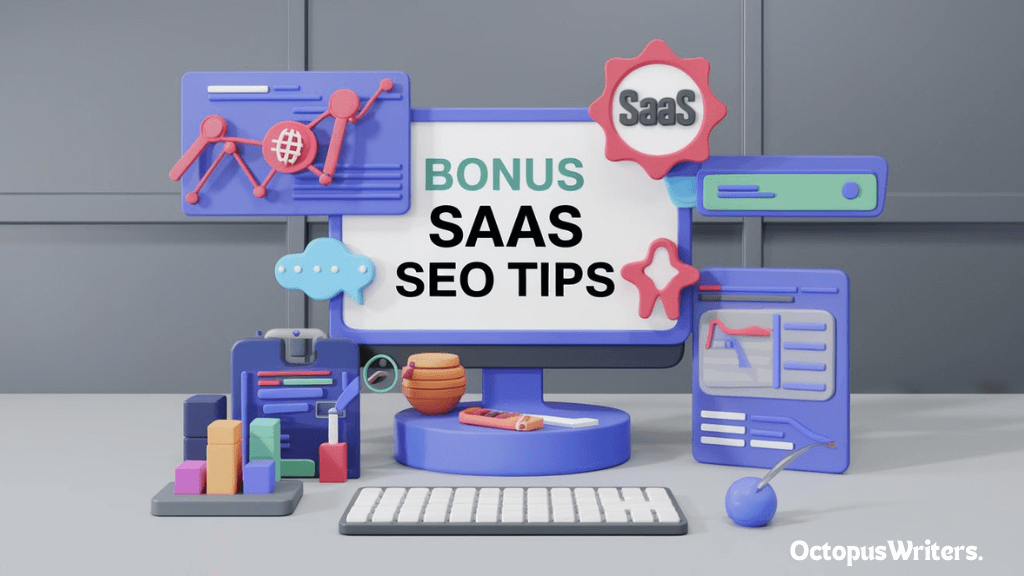
Set Up Google Search Console & Google Analytics
Google Search Console and Analytics are invaluable for understanding your site’s performance. Search Console helps track keyword impressions, clicks, and CTR, while Analytics provides detailed insights on user behavior, acquisition, top pages, and conversions, helping you fine-tune your SEO approach.
Secure Your Brand’s Identity Across Social Media Channels
SEO works best alongside a broader marketing strategy. A consistent brand presence across social media helps reinforce your SEO efforts, ensuring users find your brand both in search results and on popular platforms. Make sure to claim and standardize your brand name on all relevant networks.
Set Up Brand Mention Alerts
As your SaaS brand grows, it’s important to monitor mentions across the web. Tools like Mention and Brandwatch can help you track when your brand or products are referenced, so you can engage with users and manage your reputation.
Start Working On Your SaaS SEO Strategy
The SaaS industry is expanding rapidly, and competition is fierce. While many focus on PPC and paid channels, investing in SEO early can yield substantial long-term benefits. Use this guide to kickstart your SaaS SEO strategy today and lay a strong foundation for future growth.
Examples Of SEO For SaaS Companies
Looking to kickstart your SaaS SEO campaign? Let’s dive into two successful brands, Canva and Zapier, that have mastered the art of SEO.
Canva
Canva’s SEO success comes from creating high-value “backlink magnets” through its vast library of template pages, covering designs like invoices and invitations. These resources attract links from major sites like Yahoo and The Next Web, while Canva’s targeted outreach secures additional backlinks. Result: over 25 million backlinks and rankings for 5 million keywords.
Zapier
Zapier dominates for “integration” keywords by leveraging:
- An expansive resource center with blogs and guides
- Valuable backlinks originating from reputable websites
- Programmatic SEO, creating pages at scale for endless app integrations
Zapier’s scalable approach means it appears in search results for nearly any integration, reinforcing its authority in the SaaS space.
Tools For SaaS SEO
When it comes to enhancing your SaaS SEO strategy, there are numerous tools at your disposal. Here’s a look at some of the leading options that can significantly bolster your SEO efforts.
SEMRush
SEMRush stands out as a robust, comprehensive SEO platform designed to elevate the online presence of your SaaS business. This tool enables you to engage in competitor research, execute keyword evaluations, track your search rankings, and conduct thorough audits of your website’s SEO performance.
One of SEMRush’s standout features is its detailed competitor analysis, allowing you to gain insights into your market landscape.
Ahrefs
Ahrefs has earned a reputation as a top-tier SEO tool, particularly noted for its in-depth backlink analysis. This platform empowers you to dissect your backlink profile, uncover potential link-building avenues, and keep tabs on your competitors’ backlink strategies.
Such insights are invaluable for assessing the integrity of your backlinks, pinpointing harmful or low-quality links that could negatively impact your SEO efforts. Ahrefs also provides robust features for keyword research and content evaluation.
Google Search Console
Google Search Console is an indispensable resource for understanding your SEO performance. It provides essential insights, including the search queries that lead users to your site, your page impressions and clicks, and your rankings in search results.
Moreover, it ensures that all your web pages are indexable while assisting you in correcting common technical SEO issues that might go unnoticed. Google also supplies numerous tutorials and training videos to ease the learning process.
Screaming Frog
Screaming Frog’s SEO Spider tool allows you to view your website as Google does. By mimicking Google’s crawling process, it helps you pinpoint key areas needing improvement.
This tool is instrumental in diagnosing issues related to your site’s architecture, URL structure, content, links, and security. You will receive various alerts based on the priority of the issues, enabling you to address the most critical problems first.
Additionally, Screaming Frog integrates seamlessly with tools like Google Analytics and Search Console for a holistic view of your site’s health.
Mention
Mention is a powerful social listening tool that keeps track of online discussions about your brand. It’s an excellent resource for gauging customer sentiment and identifying any areas that may require attention to enhance your product’s positioning.
The operation of Mention is straightforward, simply enter your brand name or relevant keywords, and receive real-time insights from a multitude of sources. The tool scours social media, blogs, and videos for mentions, offering you a comprehensive perspective on audience opinions.
In addition, you’ll benefit from detailed analytics and reporting, along with alerts for specific keywords, enabling swift responses without the need to manually monitor your brand’s online reputation.
G2
G2 is a leading platform for software reviews, making it one of the first stops for customers seeking insights. Most prominent SaaS companies maintain profiles on G2, and it’s advisable for you to do the same.
Establishing a presence on G2 can significantly enhance your visibility and foster trust with potential customers, as peer reviews are often deemed more credible than traditional advertisements.
G2 also provides valuable resources such as buyer intent data, market intelligence, and integrations with various productivity tools and CRM systems.
Conclusion
Navigating the realm of SEO for SaaS may seem daunting, but with the right strategies and tools, it becomes a powerful avenue for growth and long-term success. This guide offers an extensive set of SEO strategies to boost your visibility, grow organic traffic, and ultimately drive your business forward.
If your SaaS company could benefit from specialized support, OctopusWriters is here to elevate your online presence. Our dedicated team focuses on high-quality content creation and link-building solutions, all managed with a fast-paced, results-driven approach.
Reach out to OctopusWriters today to learn more about our tailored SaaS SEO services. We’re ready to help you fuel growth, increase visibility, and unlock your company’s full online potential.
Frequently Asked Questions
What Is SaaS Copywriting? |
| SaaS copywriting is writing content with a sales focus for SaaS products. It includes creating landing pages, sales pages, website copy, and ad content for social media and PPC, all aimed at driving sales. |
What Is SaaS Content Writing? |
| SaaS content writing focuses on creating valuable, informative content that attracts potential SaaS customers, raising awareness and encouraging conversions. This type of content is crafted to engage users at the top of the SaaS sales funnel. |
What Is B2B SaaS Content? |
| B2B SaaS content targets business audiences for SaaS products, aiming to draw in potential business clients and increase brand and product awareness. |
Should You Hire A SaaS SEO Agency? |
| Hiring an SEO agency depends on your budget, time frame, and in-house skills. If you have SEO expertise on your team and aren’t in a rush for results, you may manage well without an agency. |
How Long Does It Take To See Results From SEO For SaaS? |
| SEO results typically take around three months to start showing as rankings build gradually. Expect noticeable results, such as leads and conversions, at around six months as your SEO and marketing funnel gain traction. |
How Much Does SEO For SaaS Cost? |
| SaaS SEO costs vary widely based on pricing models and needs. For hourly SEO services, rates range from $75 to $250, while monthly retainers fall between $1,000 and $10,000. In-house SEO adds costs like salaries (averaging $60,000 per year in the U.S.), training, and SEO tools such as OctopusWriters. |

